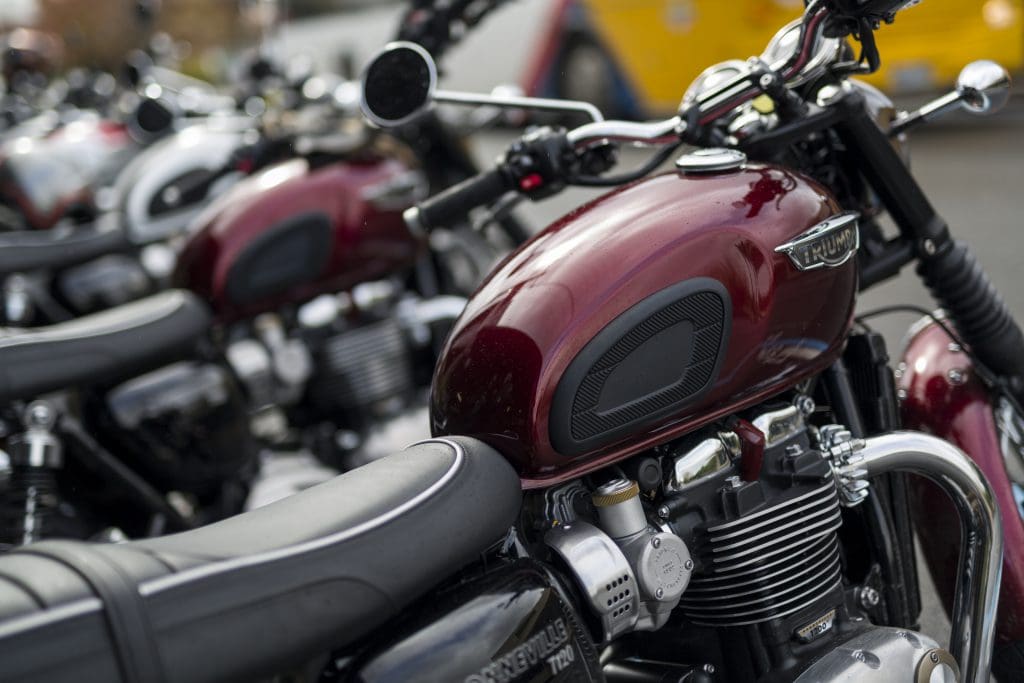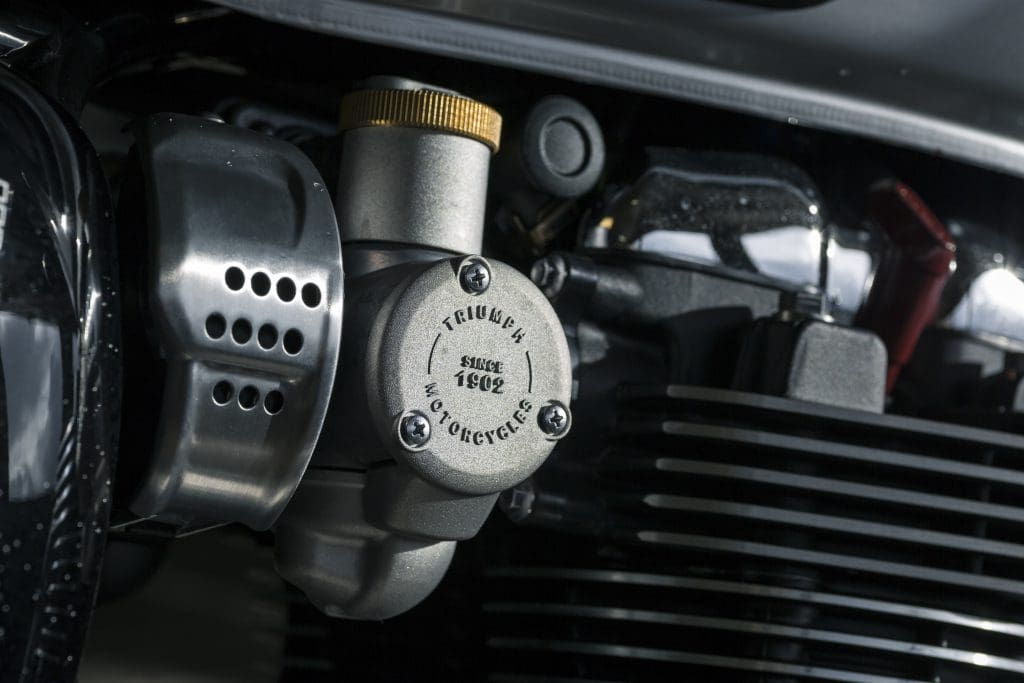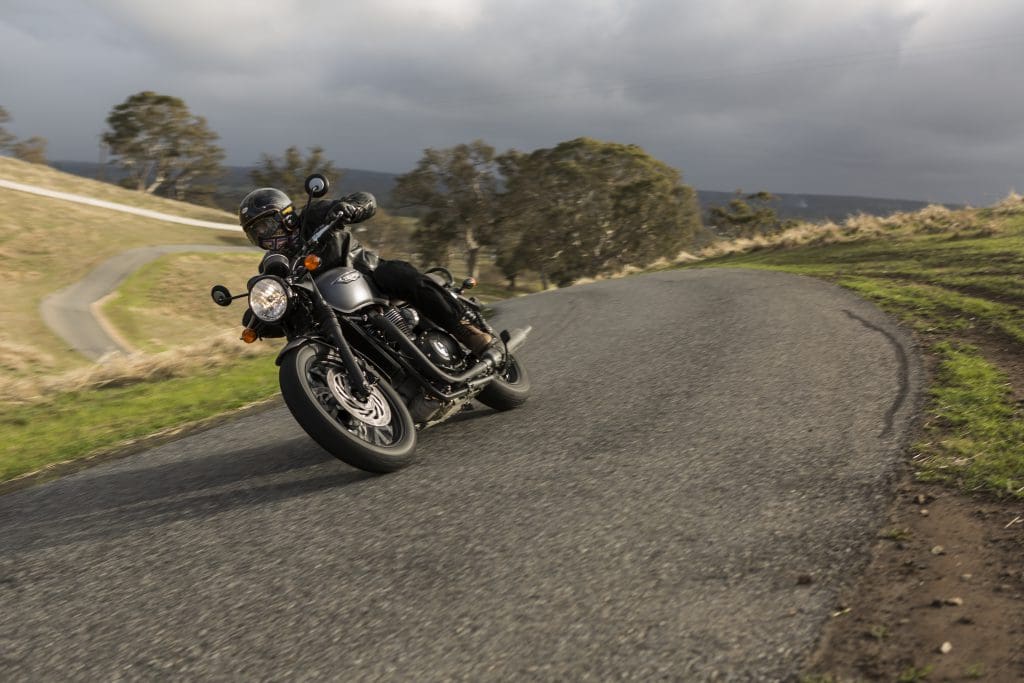The snaking gully roads of the Adelaide Hills and the open countryside of the Barossa Valley recently laid host to the Australian launch of the Bonneville T120, and as a location for a bike with nostalgia at its heart and simple riding pleasure as its goal, the location couldn’t have been better chosen. For me, it was also a pleasure to return to the roads where I learned to ride, made all the more satisfying by a motorcycle with as much calm character as the hills themselves.
You only have to look at how many new models are coming out of their UK-based design department lately to know Triumph motorcycles are on a mission, to modernise their entire range. 2016 has been the year for Triumph’s to bring its popular heritage models up-to-date en masse, first with the Bonneville Street Twin, then the Thruxton and T120.
The test report below is a comparison between my seat of the pants impression of the T120 in action, and the marketing spiel created to stir our emotions and open our wallets.

They say: Inspired by the legendary 1959 Bonneville and styled to incorporate the original’s iconic features, the new Bonneville T120 reaches a whole new level of detailing, quality and finish -including deep chrome multi-piece Triumph tank badges, grab rail and innovative twin-skinned chrome exhaust headers and peashooter style silencers. The new Bonneville T120 is a stylish and distinctive statement of Triumph’s past, present and future. A genuine icon, beautifully evolved.
Youngy says: Too true. There are many truly impressive aspects to this new Triumph T120, but what hits you before even firing it into life or having the opportunity to test its performance, is the tremendous effort that has gone into authenticating the heritage of the model, and also the quality invested in the finished product. If the previous generation of Bonneville models were a cheap and cheerful nod to the rich heritage of Triumph’s most famous model, the 2016 range are a classy, elegant and tasteful homage to those British originals. They have also thoughtfully and respectfully brought the heritage look to what is in practice a thoroughly modern motorcycle in terms of its technology and performance. Great care appears to have been given to get this balance right, and I reckon Triumph’s designers have got it spot on.

They say: Powered by an all new ‘high-torque’ engine and fed by beautiful authentic twin throttle bodies, the 1200cc power plant is specifically built for this modern classic. The T120 has a torque rich engine, with good low down power delivery without the need to use excessive revs.
Youngy says: Producing this type of engine, tuned for a wide spread of torque from low revs, shows an intent to give riders what they need, rather than give them what they often think they need. Massive horsepower and torque figures mean nothing if delivered in a lumpy or peaky manor which makes the bike harder to ride. The T120 has grunt by the bucket-load straight from idle, and produces maximum torque between 3000 and 3500 rpm. But don’t expect to feel the drive drop away or a second kick when the kW curve takes over, because it’s just one long flat ribbon of meaty acceleration from a standstill all the way to the rev limiter. So, no, you don’t need to rev the engine to get anywhere, but then you don’t necessarily need to short shift either. Flexibility is the T120 engines strong point, so while keeping the rpm very low as recommended in the brochure does feel like the natural way to ride it, its broad torque curve also lets you cut down on gear changes by running it out to maximum revs without it ever coming off the boil.

They say: The bike feels strong in general riding scenarios, but is not intended to hit high top speeds or generate huge levels of power.
Youngy says: It’s a strange thing for Triumph’s marketing blurb to be down-playing this aspect of the bikes performance, where really there is no need to say anything about top end power or top speeds achievable. As it is, the T120’s power figure is unimportant with so much torque on tap, and that healthy torque figure actually propels the sit-up version of the 1200cc Bonneville to an extremely respectable top speed of over 200km/h. Can’t tell you how I know that, I just do. OK?

They say: The bike provides effortless roll-ons even two-up and touring, capability is further boosted by the 6-speed gearbox.
Youngy says: Again, it’s all about the grunt, and that’s always good for dragging a pillion around or loading up for spot of touring. The over-drive sixth gear is the icing on the cake, as without the sort of torque curve the T120 has, it just wouldn’t pull such a tall gear. It’s huge! Sitting at around 110km/h in top equates to a fairly leisurely 3000rpm, which is also exactly the engine speed where the 500rpm plateau of peak torque starts. So not only does the T120 hum along smoothly at legal highway speeds, it’s also sitting at the perfect engine speed to blast past anything in your way without the need to knock it back a gear.
They say: The parallel twin engine’s 270° firing interval gives a distinctive character & exhaust tone plus improved NVH (reduced vibration) compared to a 360°crank.
Youngy says: The previous Bonneville engine wasn’t without character; in fact, I would argue it had a little bit too much character for a bike born in the 21st century. Mimicking the look of a classic is one thing, but I don’t need the vibrations which kept Loctite in business for decades to appreciate the old-world charm of a British parallel-twin. In comparison, this all-new Bonneville is a real smooth operator, and feels every bit a modern incarnation of the historic Marque’s models of yesteryear, thankfully without the finger-whitening, bum-numbing disposition of days gone by.
They say: Features an all-new chassis and suspension, set-up and developed for relaxed and refined riding everyday, all-day. Alone or with a pillion passenger. Combining Triumph’s signature ride dynamic of neutrality, agility and stability with advanced levels of comfort and control, for an engaging yet easygoing experience.
Youngy says: It was no-brainer that Triumph would have to create a new chassis to meet the demands of the more powerful new generation Bonneville engine, and the lifting of quality seen elsewhere on the bike is just as prevalent here. The KYB cartridge style forks and twin rear shocks are a big improvement on the outgoing model, but it’s the increased rigidity built into the swingarm which really sets it apart from it slightly wayward steering predecessor. This is a retro roadster which can really be thrown around in the twisty bits. Adjustable spring preload at the rear gives you some level of tuning for pillion duties or eating too many pies, while the non-adjustable damping in the KYB units feels well set-up, and is plush without feeling loose when you really get going.
They say: ABS is the contemporary safety standard.Triumph’s anti-lock braking system brings a new level of control to the Bonneville T120.
Youngy says: Never mind the ABS, it’s just great to see twin-discs up front on the new T120, and the whole braking system is well-matched to the bikes potential. The far less powerful previous generation Bonnies were woefully under-gunned in the brake department, and this is another area I have absolutely no desire to accept yesteryears performance in a modern version of a retro-styled machine. Motorcycle control freaks like me will always want the ability to disable ABS, something not possible on the T120, but for this type of bike the single setting system works well and will appeal to the majority of the bike’s target audience.
They say: Taking advantage of the sophisticated ride-by-wire system the T120 incorporates a switchable traction control system that optimizes the delivery of its class leading torque. Two selectable Mode options ‘road and rain’ provide the rider with greater control and safety.
Youngy says: As can be seen in the pic of me launching the T120 up the Collingrove Hillclimb course, having so much grunt from the get-go can be a recipe for some glorious wheel spin. Depending on whether that excites or scares the bejesus out of you, will no doubt determine whether you tend to leave the traction control switched on or off. Having that option is a wonderful thing, because it makes for a bike versatile enough to satisfy seasoned riders, as well as keeping the T120 a sensible option for a first non-LAMS bike. One which can ease learners safely into big bike ownership.

Because its power delivery is tuned to be so smooth and progressive in all situations, the change in the T120’s behavior between Road and Rain rider modes is far subtler than is usually the case on bikes with this option; To the point that I suspect selecting Rain mode will do more for calming novice nerves in slippery conditions than it will for making the bike easier to ride, just so long as the TC is also switched on and that monster torque is kept on the leash.
Summary: This was an extremely important project for Triumph. Bonneville family sales have been a staple source of income for the British brand, helping fund their steady rise to glory. So, a total redesign like this has a lot riding on its success. The gravity of the task at hand was quite obviously not lost on the design team responsible for delivering Triumph’s modern-retro future, as the finished article is high quality, stylishly detailed and totally functional. It’s not just an improvement on the previous T120, it’s so much more than that. To ride the 2016 model back-to-back with the old bike is like jumping forward two, maybe three decades in time, but on a bike which has more class, and is more authentic to its heritage than any of the Hinckley Bonnevilles which have come before it.
The Bonneville legacy is in very good hands indeed.












